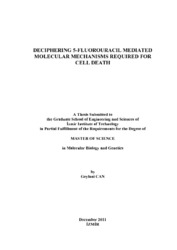Please use this identifier to cite or link to this item:
https://hdl.handle.net/11147/3166Full metadata record
| DC Field | Value | Language |
|---|---|---|
| dc.contributor.advisor | Baran, Yusuf | - |
| dc.contributor.author | Can, Geylani | - |
| dc.date.accessioned | 2014-07-22T13:51:01Z | - |
| dc.date.available | 2014-07-22T13:51:01Z | - |
| dc.date.issued | 2011 | - |
| dc.identifier.uri | http://hdl.handle.net/11147/3166 | - |
| dc.description | Thesis (Master)--Izmir Institute of Technology, Molecular Biology and Genetics, Izmir, 2011 | en_US |
| dc.description | Includes bibliographical references (leaves: 26-31) | en_US |
| dc.description | Text in English; Abstract: Turkish and English | en_US |
| dc.description | ix, 31 leaves | en_US |
| dc.description.abstract | The chemotherapy agent 5-Fluorouracil (5-FU) is an antimetabolite that has been in use to treat several cancers for decades. In cells, it is converted into three distinct fluoro-based nucleotide analogues which interfere with DNA-synthesis and repair leading to impairment of the genome and, eventually apoptotic cell death. Current knowledge also state that 5-FU induced damage is signaling through a p53-dependent induction of death inducing complex (DISC) formation and further caspase-8 activation in certain cell types and members of the TNF-receptor family has been proposes to be required for the process. Here, we introduce calcium (Ca2+) as a messenger for p53 activation in the cellular response triggered by 5-FU. Using a combination of pharmacological and genetic approaches, we show that treatment of cultured colon carcinoma cells stimulates entry of extracellular Ca2+ through L-type plasma membrane channels and that this event direct posttranslational phosphorylation of at least two specific p53 serine residues (ser15 and ser33) by means of Calmodulin (CaM) activity. Obstructing this pathway by the Ca2+-chelator BAPTA or by two different inhibitors of CaM efficiently blocks 5-FU-induced cell death. The fact that a widely used therapeutic drug, such as 5-FU, is signaling by these means could provide new therapeutic intervention points, or specify new combinatorial treatment regimes. | en_US |
| dc.language.iso | en | en_US |
| dc.publisher | Izmir Institute of Technology | en_US |
| dc.rights | info:eu-repo/semantics/openAccess | en_US |
| dc.subject.lcsh | Molecular biology | en |
| dc.subject.lcsh | Apoptosis | en |
| dc.subject.lcsh | Death receptors | en |
| dc.subject.lcsh | p53 antioncogene | en |
| dc.subject.lcsh | Cancer | en |
| dc.title | Deciphering 5-Fluorouracil Mediated Molecular Mechanisms Required for Cell Death | en_US |
| dc.type | Master Thesis | en_US |
| dc.institutionauthor | Can, Geylani | - |
| dc.department | Thesis (Master)--İzmir Institute of Technology, Molecular Biology and Genetics | en_US |
| dc.relation.publicationcategory | Tez | en_US |
| dc.identifier.wosquality | N/A | - |
| dc.identifier.scopusquality | N/A | - |
| item.openairecristype | http://purl.org/coar/resource_type/c_18cf | - |
| item.openairetype | Master Thesis | - |
| item.languageiso639-1 | en | - |
| item.cerifentitytype | Publications | - |
| item.grantfulltext | open | - |
| item.fulltext | With Fulltext | - |
| Appears in Collections: | Master Degree / Yüksek Lisans Tezleri | |
Files in This Item:
| File | Description | Size | Format | |
|---|---|---|---|---|
| T000980.pdf | MasterThesis | 4.13 MB | Adobe PDF |  View/Open |
CORE Recommender
Page view(s)
354
checked on May 12, 2025
Download(s)
172
checked on May 12, 2025
Google ScholarTM
Check
Items in GCRIS Repository are protected by copyright, with all rights reserved, unless otherwise indicated.